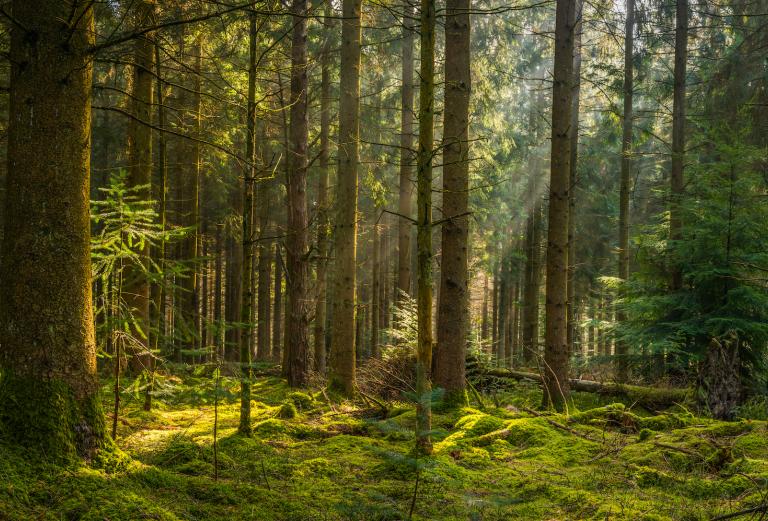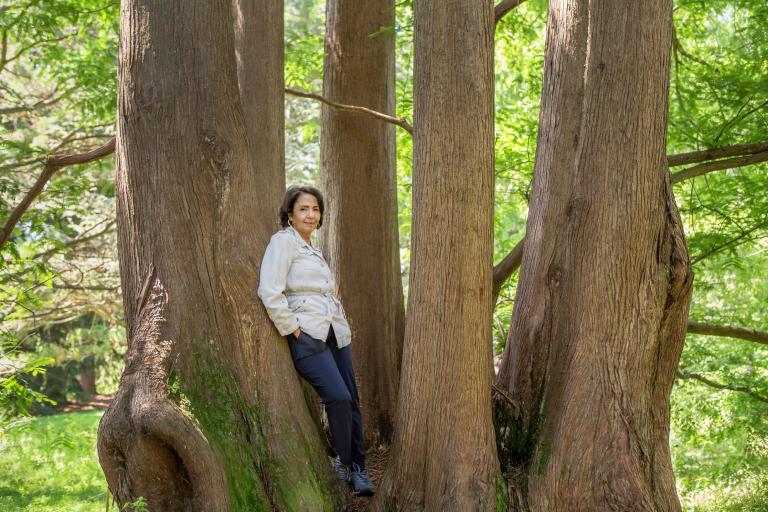A Walk in the Woods May Boost Mental Health
Many physicians are prescribing time in nature as balm for the brain
- 7 minute read
- Feature

When a patient visits California-based physician Daphne Miller, MD ’93, they sometimes leave with a prescription that seems a bit unconventional.
The prescription doesn’t come in a pill bottle or require insurance approval. And it won’t have negative side effects — aside from the occasional sunburn or bug bite. Rather, it looks something like this:
Drug: Time on the Richmond Bay Trail. Dose: 45 minutes. Directions: Monday, Wednesday, Friday, and Saturday at 7:00 AM. Refill: Unlimited.
Miller often prescribes doses of nature as a part of broader treatment plans for mental health issues like grief, depression, or anxiety. She insists that a tangible script for time outside can work wonders — and that she’s not the only one who thinks so. “Nature prescriptions are increasingly popular,” she says. “Lots of folks are looking at what nature does to your brain and finding objective data to back it up.”
The cognitive benefits of time in nature
Peter James is one of those folks. James, an HMS associate professor of population medicine in Harvard Pilgrim Health Care Institute’s Department of Population Medicine, used data from the Nurses’ Health Study — which has followed a cohort of 121,000 women for decades — to explore links between nature and health. Pairing medical records with satellite data, James and colleagues discovered that women living in the areas with the highest amount of green space were 12 percent less likely to die during an eight-year follow-up period. As described in a 2016 paper in Environmental Health Perspectives, this association was strongest for cancer and respiratory mortality.
James, who is also an associate professor of environmental health at the Harvard T.H. Chan School of Public Health, wondered why green spaces might lower the risk of death. Was it because plants absorb air pollutants? That people living near parks get more exercise? Analyzing the underlying mechanisms and controlling for factors like socioeconomic status, he and his colleagues were surprised to learn that neither physical activity nor levels of pollution explained the decrease in mortality rate. Rather, mental health — measured as diagnosed depression or antidepressant use — was the most important driver identified. Social engagement played a lesser, but important, role.
There is no one pharmaceutical or precision medicine tool that could ever have the broad benefits of a forest.
The research adds to a robust body of evidence indicating that our brains benefit from getting outside. Studies comparing participants’ mental health after they’ve spent time in natural environments versus built environments have revealed physiological differences — such as lowered salivary cortisol levels, a biomarker of stress, or reduced activity in brain regions implicated in rumination, a cycle of negative thoughts — between those who spent time in nature and those who did not. Even being in indoor rooms with windows that allowed views of nature or contained natural features, like plants, has been linked to cognitive benefits.
The idea that we’re somehow programmed to find solace in greenery is “not rocket science,” says James, who is now using Google Street View images and deep learning algorithms to home in on the exact components of nature, such as the proportion of trees, grass, or flowers in a given area, that drive health outcomes. He points out that the value of green space is baked into many aspects of our lives, from real estate prices to spa soundtracks featuring nature sounds. “The truth is, we are nature,” he says. “We were not evolved to be in a windowless room staring at a computer screen. These artificial environments make us stressed. They force us to focus more than we want to, and they tire our cognitive function.”
Forest therapy
Susan Abookire, MD ’91, would agree. “We evolved in relationship with the trees,” she says. “If you look at the science, you see how, for example, the aromatic compounds of the forest affect our immune systems, or how dirt regulates the microbiome of our guts. There is no one pharmaceutical or precision medicine tool that could ever have the broad benefits of a forest.”

Nature is both a healer and co-teacher for Abookire, an HMS assistant professor of medicine at Brigham and Women’s Hospital, who has spent her career designing complex health care systems. Several years ago, she began bringing students in her system design courses outdoors to explore the complexity of natural ecosystems. That’s how she got interested in forest bathing, or shinrin-yoku — a therapeutic practice of Japanese origin that involves spending time in the forest. Since the Japanese government began promoting the practice in the 1980s, hundreds of studies have highlighted its link to improved mental health.
Abookire saw the potential of the practice to aid her medical students and colleagues with a problem that pervades health care work: burnout. So she earned a certification in forest therapy.
Each month she brings groups of Brigham and Women’s medical residents out into verdant corners of Harvard University’s Arnold Arboretum, located in Boston. She guides them to notice the smells, sights, and sounds of the forest; perceive the movements of plants; and feel connections with nearby trees.
Abookire says she is always impressed with the revelations the residents describe in the discussions that follow these outings, and the parallels with nature that they see in their own work: An ecosystem erupting from a dead tree recalls the cycle of life and death; the unexpected textures of plants reflect the importance of human touch in medicine. And the sessions give them a much-needed chance to reset and recharge. “Having an opportunity to really become aware and embodied in our senses changes the neurobiology of our state of being,” Abookire says. “It activates the parasympathetic nervous system and kind of lets the other stuff rest — all the stuff we do in the frontal cortex and sympathetic nervous system.”
Green space for everyone
Yet you don’t need a certified forest therapy guide — or even a full-fledged forest — to reap the benefits of green space. “Even a city park, even a little patch of grass is beneficial,” Abookire says, so long as a few ingredients are present: the feeling that you’ve been able to get away from regular life and a natural element to focus attention on. She points to a 2019 study in Frontiers in Psychology that allowed urban-dwelling participants to choose the time, place, and duration of their nature experiences. Researchers found that even 20 minutes of these flexible “nature pills” three times per week yielded benefits like lowered salivary cortisol levels.
“The ultimate goal is not to go to Yosemite,” echoes James. “The literature says that people do better in cities and other places that have incorporated nature, vegetation, trees, and parks. What we really need to do is incorporate nature into everyday life.”
But even small doses of greenery are hard to come by in some places. James hopes his research will encourage policymakers and urban planners to design cities with more equitable access to green space. Studies suggest that lower-income neighborhoods get an even bigger health benefit from green spaces than wealthy communities do. “You can imagine adding another advantage to a wealthy community isn’t going to do much,” he says, “but if you can add green space in places where none exists, it could benefit people’s health substantially.”
“Anything we can do to bridge the green divide and create green space equity is going to change health outcomes,” says Miller. The community of North Richmond, California, where she practices, has some of the highest rates of chronic disease, houselessness, and poverty — as well as some of the lowest quantities of per capita green space — in the Bay Area. But she has observed that even trips to the small park or the urban farm down the road from the clinic make a difference to patients.
“I personally would love for access to green space to be a vital sign,” she says. “When patients come in, we check their blood pressure and heart rate. Why don’t we ask, ‘Is there green space near your home that you can safely walk to and enjoy?’”
Molly McDonough is the associate editor of Harvard Medicine magazine.
Images: fotoVoyager/E+/Getty Images (top); John Soares (Abookire)